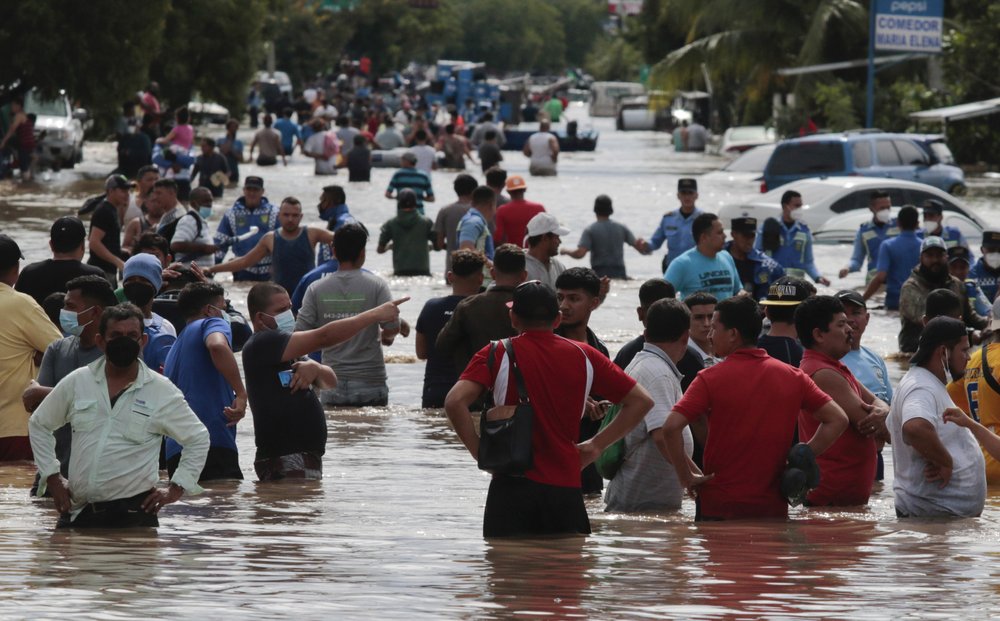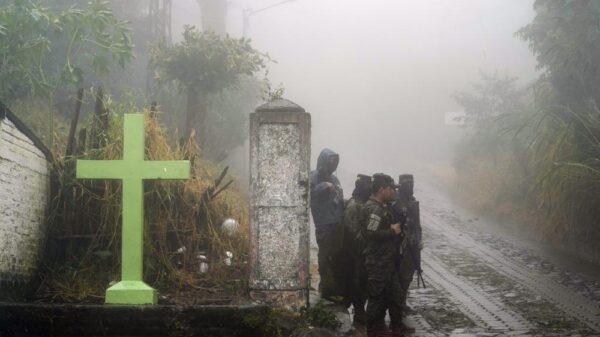Residents wade through a flooded road in the aftermath of Hurricane Eta in Planeta, Honduras, Thursday, Nov. 5, 2020. The storm that hit Nicaragua as a Category 4 hurricane on Tuesday had become more of a vast tropical rainstorm, but it was advancing so slowly and dumping so much rain that much of Central America remained on high alert. (AP Photo/Delmer Martinez)
ST. PETERSBURG, Fla. (AP) — Iota became the thirteenth hurricane of the Atlantic season early Sunday, threatening to bring another dangerous system to Nicaragua and Honduras — countries recently clobbered by a Category 4 Hurricane Eta.
Iota was already a record-breaking system, being the 30th named storm of this year’s extraordinarily busy Atlantic hurricane season. Such activity has focused attention on climate change, which scientists say is causing wetter, stronger and more destructive storms.
The U.S. National Hurricane Center said Sunday morning that Iota had maximum sustained winds of 80 mph (130 kph), making it a Category 1 hurricane. But, forecasters said Iota would rapidly strengthen and was expected to be a major hurricane by the time it reaches Central America.
Iota was centered about 275 miles (445 kilometers) east of Isla de Providencia, Colombia, and was moving west at 6 mph (9 kph) Sunday morning. Forecasters said Iota was expected to pass or cross over Providencia sometime Monday and then approach the coasts of Nicaragua and Honduras on Monday evening.
The system was forecast to bring up to 30 inches (750 millimeters) of rain from northeast Nicaragua into northern Honduras. Costa Rica, Panama and El Salvador could also experience heavy rain and possible flooding, the hurricane center said.
Forecasters said the island of Providencia and parts of Nicaragua and Honduras were under hurricane warnings. Storm surge could increase water levels by up to 13 feet (4 meters) in Nicaragua and Honduras.
Iota threatened to wreak more havoc in a region where people are still grappling with the aftermath of Eta. That system hit Nicaragua just over a week ago as a Category 4 hurricane, killing at least 120 people as torrential rains brought flash floods and landslides to parts of Central America and Mexico. Then it meandered across Cuba, the Florida Keys and around the Gulf of Mexico before slogging ashore again near Cedar Key, Florida, and dashing across Florida and the Carolinas.
Eta was the 28th named storm of this year’s hurricane season, tying the 2005 record for named storms. Theta, the 29th, was weakening over the far eastern Atlantic Ocean. It was expected to become a remnant low sometime Sunday, forecasters said.
The official end of hurricane season is Nov. 30.
Frisaro reported from Fort Lauderdale, Florida.
Copyright 2020 Associated Press. All rights reserved.









































